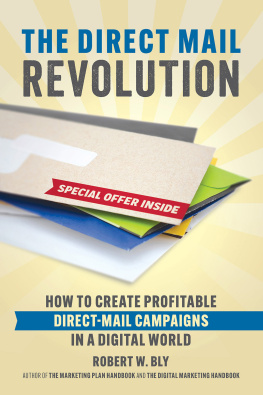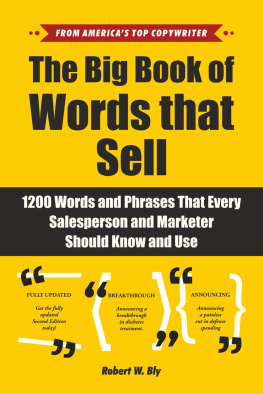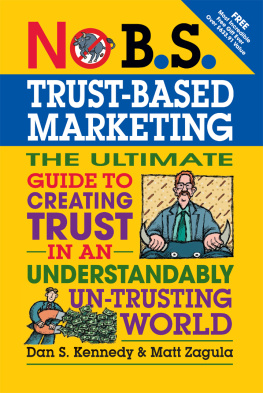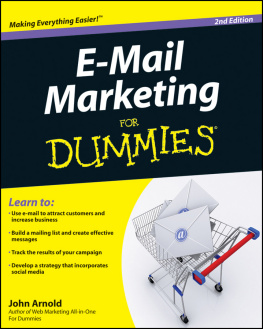
Reports of the death of direct mail have been greatly exaggerated, and Bob Bly proves it in this powerful new book, The Direct Mail Revolution. With email response rates dropping like rocks, postal mail is poised for a major comeback. Blys bookwhich could be called Direct Mail 2.0serves as both a superb primer for those whove never managed a direct-mail campaign before and an excellent refresher for those who have.
RICHARD ARMSTRONG, DIRECT-MAIL COPYWRITER
Marketers are starting to realize that digital marketing is not the end-all solution for direct marketing. Bobs new book arrives just in time. Its a vital resource that helps organizations improve their ROI when implementing direct-mail promotions to clients and prospects.
MICHAEL BORKAN, CEO OF TALON MAILING AND MARKETING
The Direct Mail Revolution is a treasure trove of easy-to-follow how-to advice on direct mail and digital marketing tricks of the trade. Both novices and professionals alike can boost their income from the proven direct-mail campaigns, valuable checklists, and sales funnels alone. Must read!
ANDREW S. LINICK, PH.D., THE MARKETING COPYOLOGIST AND FOUNDER OF THE COPYWRITERS COUNCIL OF AMERICA
Of all the books Ive read in 50 years of being in the mail order business, Bobs new book is one of the best Ive ever read!
GEOFFREY FELDMAN, MDG MARKETING SERVICES, LLC
Bob is a first-rate copywriter and direct marketing strategist. I would recommend this book to anyone who either wants to brush up on their direct-mail marketing or get involved in this proven marketing channel to grow their business.
BRUCE BROWNING, PRESIDENT OF OLLEYMAY MEDIA
THE DIRECT MAIL
REVOLUTION
HOW TO CREATE PROFITABLE
DIRECT MAIL CAMPAIGNS
IN A DIGITAL WORLD
ROBERT W. BLY
Entrepreneur Press
Entrepreneur Press, Publisher
Cover Design: Andrew Welyczko
Production and Composition: Eliot House Productions
2019 by Entrepreneur Media, Inc.
All rights reserved.
Reproduction or translation of any part of this work beyond that permitted by Section 107 or 108 of the 1976 United States Copyright Act without permission of the copyright owner is unlawful. Requests for permission or further information should be addressed to Entrepreneur Media Inc. Attn: Legal Department, 18061 Fitch, Irvine, CA 92614.
This publication is designed to provide accurate and authoritative information in regard to the subject matter covered. It is sold with the understanding that the publisher is not engaged in rendering legal, accounting, or other professional services. If legal advice or other expert assistance is required, the services of a competent professional person should be sought.
Entrepreneur Press is a registered trademark of Entrepreneur Media, Inc.
ebook ISBN: 978-1-61308-389-5
This book is for Dr. Krishna Maruri

CONTENTS
ACKNOWLEDGMENTS
S ome sections of this book were published, in slightly different form, in several earlier and now out-of-print books of mine, Power-Packed Direct Mail, The Complete Idiots Guide to Direct Marketing, and The White Paper Marketing Handbook. Others appeared, also in slightly different form, in direct-response industry trade publications including DM News, Business Marketing, and Target Marketing.
I would like to thank Bob Diforio, my agent, for finding a good home for this book at Entrepreneur Press. Thanks also to my editor, Jennifer Dorsey, for making the book much better than it was when the manuscript first crossed her desk. And to Vanessa Campos, thanks for bringing the book to the attention of businesspeople who can profit from it.
Lastly, I want to thank the many marketers who let me share their ideas, tactics, and samples of their work in this book. I cant name you all. But you know who you are, folks.
Introduction
THE NEW DIRECT-MAIL REVOLUTION
W hen email marketing began around 1978, emails low cost (essentially free), ease of sending (just click a button), speed of transmission (almost instant), and superior response rates made many marketers think direct mail (DM) had become obsolete. But the use of marketing tactics is usually cyclical. Today, email open and click-through rates have declined. Thanks to spam filters and firewalls, email deliverability has dropped dramatically. Worse, people are bombarded with so many emails that they have their finger poised over the delete key as they go through their inbox. And they fear viruses, malware, phishing schemes, and other online scams. As a result, direct mail has made a dramatic comeback.
POWERFUL EVIDENCE OF DIRECT MAILS COMEBACK
Did you know that direct-mail response rates took a tremendous leap in 2017? According to the Direct Marketing Associations (DMA) 2017 In 2015, the response rates from house and outside lists were 3.7 percent and 1.0 percent respectively, and in 2010 were 3.4 percent and 1.4 percent.
Another reason for the rebirth of direct mail is that, despite the rising costs of paper, postage, and mailing lists, direct mail generates a tremendous return on investment (ROI). On average, U.S. advertisers spend $167 per customer on direct mail annually to sell $2,095 worth of goods per buyer.
Even more important, in the decade from 2006 to 2016, the total volume of mail handled by the U.S. Postal Service (USPS) fell 27.7 percent. With less mail competing for the consumers attention, your direct-mail piece has a better chance of being noticed, read, and responded to. Need more convincing? Check out these facts:
 2017 DMA report says that direct mail continues to provide the best response rate of any marketing channel; for example, a #10 DM package mailed to a house file had an average response rate of 4.37 percent.
2017 DMA report says that direct mail continues to provide the best response rate of any marketing channel; for example, a #10 DM package mailed to a house file had an average response rate of 4.37 percent.
 The Winterberry Group, a marketing consulting firm, says that 29 percent of marketers media budgets is still spent on direct mail.
The Winterberry Group, a marketing consulting firm, says that 29 percent of marketers media budgets is still spent on direct mail.
 In 2013, U.S. companies sent out a staggering 80 billion pieces of direct mail, which stood out against the reduced volume of regular mail.
In 2013, U.S. companies sent out a staggering 80 billion pieces of direct mail, which stood out against the reduced volume of regular mail.
 More than 80 percent of local small businesses use direct mail to reach their customers.
More than 80 percent of local small businesses use direct mail to reach their customers.
 Branded products on average get a 1,300 percent ROI from direct mail.
Branded products on average get a 1,300 percent ROI from direct mail.
 Direct-mail packages generate 78 percent of all donations made to nonprofits.
Direct-mail packages generate 78 percent of all donations made to nonprofits.
 More than 40 percent of recipients scan or read the direct-mail pieces they get.
More than 40 percent of recipients scan or read the direct-mail pieces they get.
Next page














 2017 DMA report says that direct mail continues to provide the best response rate of any marketing channel; for example, a #10 DM package mailed to a house file had an average response rate of 4.37 percent.
2017 DMA report says that direct mail continues to provide the best response rate of any marketing channel; for example, a #10 DM package mailed to a house file had an average response rate of 4.37 percent.